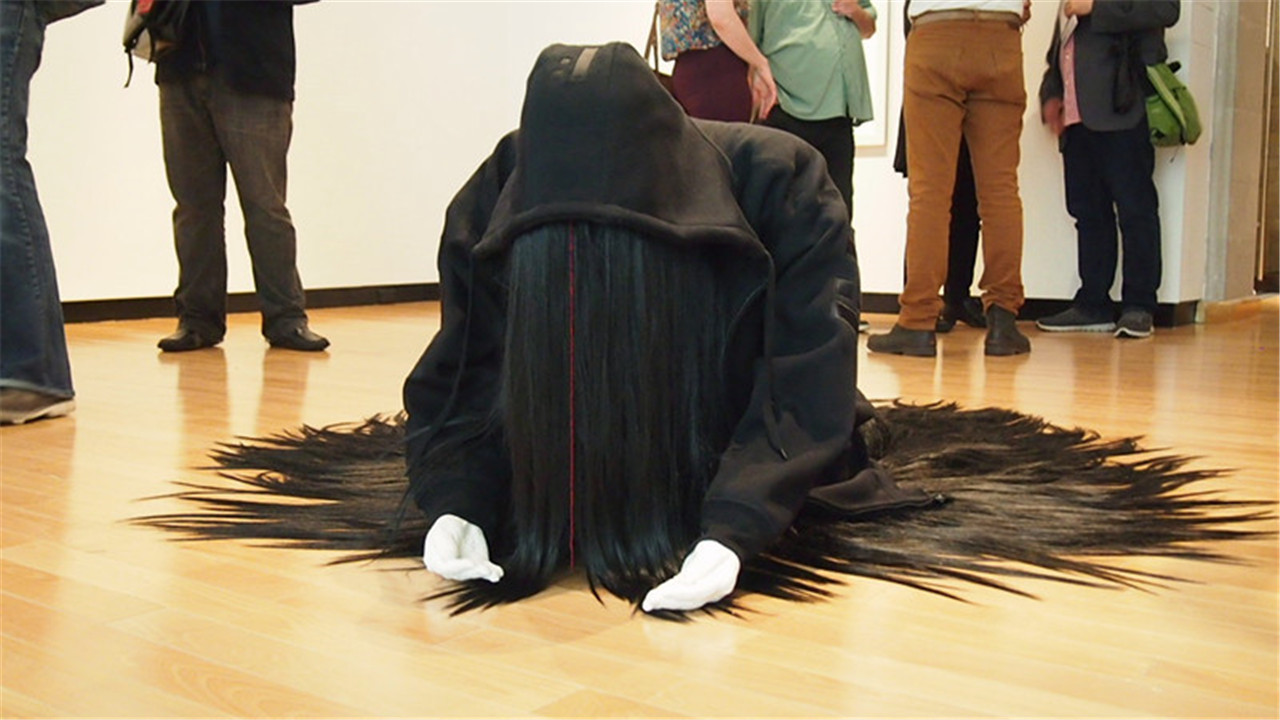Art is often described as a catalyst for change, but creating art with a predisposed agenda can lead to artworks that appears forced or cliché. In the case of Rebecca Belmore’s KWE exhibit, the show lacks the nuances and subtlety necessary to be described as “poetic political intervention” as the catalogue claims.
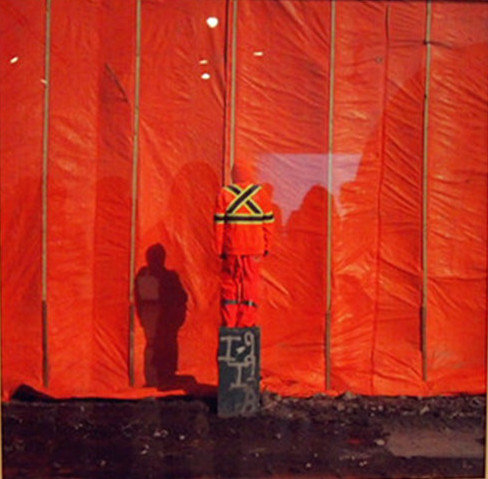 Rebecca Belmore, artist, 2014. Photograph by Scott Benesiinaabandan. Photo: Summer Sun.
Rebecca Belmore, artist, 2014. Photograph by Scott Benesiinaabandan. Photo: Summer Sun.
Perhaps, the most successful piece in the show is Belmore’s artist, photographed by Scott Benesiinaabandan. The photograph portrays a somewhat anonymous labourer who stands upon an electric box with an orange construction tarp as a backdrop. The labourer, who the viewer can assume is the artist, Belmore, is wearing an orange uniform that has an “X” on the back. While this photograph appears simple, it deals with the deep issue of the marginalization of the individual in society such as, the artists, the labourer or First Nations people. The most astonishing aspect of this image, however, is the composition and how easily the photo can be reduced into rectangles, lines and colour. There is nothing convoluted or precocious about this photo; it is a statement – simple and clear.
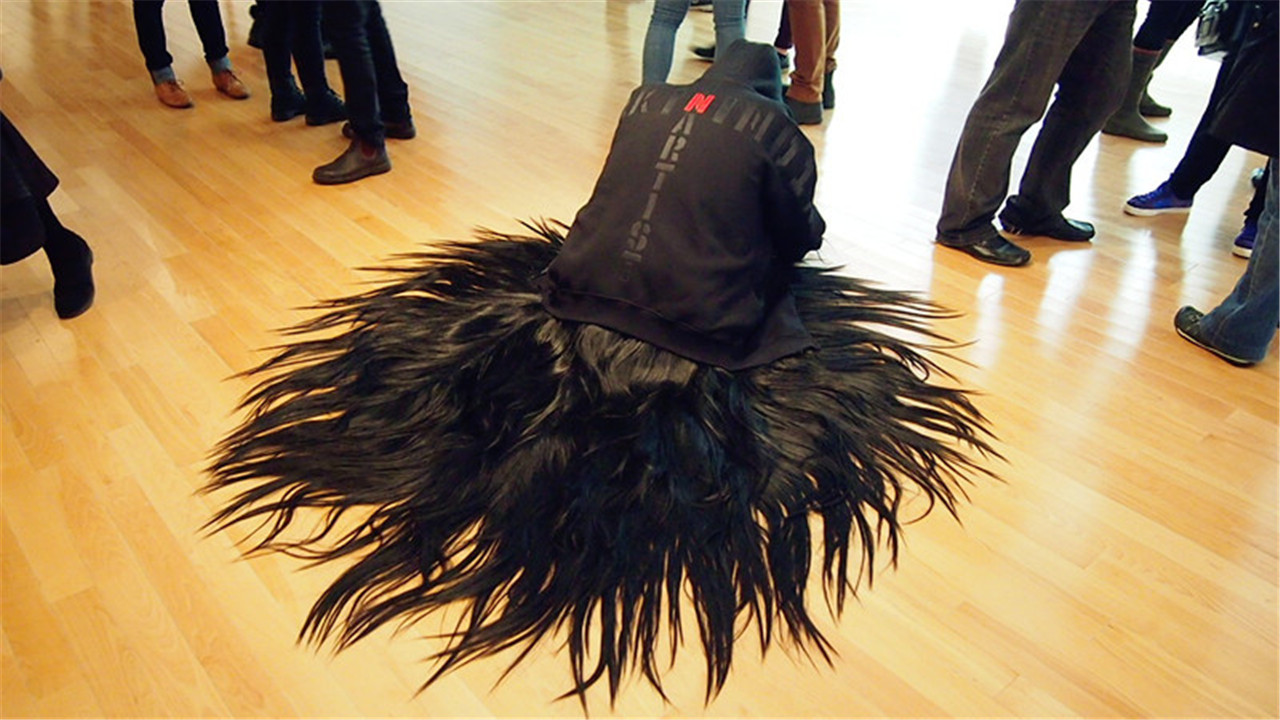 Rebecca Belmore, Mixed Blessing, 2011. Front (top) and back (bottom) view. Photo: Summer Sun.
Rebecca Belmore, Mixed Blessing, 2011. Front (top) and back (bottom) view. Photo: Summer Sun.
While artist is clear and allows the viewer to pick up subtle hints, Mixed Blessing is perhaps too literal. The sculpture depicts an individual clad in a black hoody, crouching on the ground. The person’s face is obscured by thick black hair which pools around the body like a halo. The back of the hoody has two statements that intersect. Horizontally it reads “Fuckin Indian”, and vertically it reads “Fuckin Artist.” The two statements are joined by the red “N” they share in “Fuckin.” The sculpture is angst ridden and so wrapped up in self-pity that it is hard to comprehend the true and serious intentions of the work.
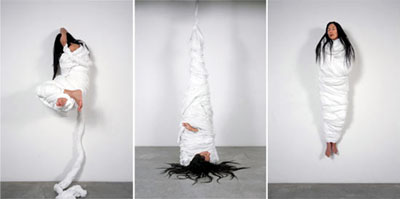 Rebecca Belmore, Untitled #1, #2, #3, 2004.
Rebecca Belmore, Untitled #1, #2, #3, 2004.
Untitled #1, #2 and #3 all have a similar issue. Each photograph is of a woman suspended off a white wall wrapped in white sheets. The pieces are beautifully positioned, creating awkward and intriguing forms. However, the symbolism and concept of constraining the body to represent outer constraints on the individual is simply cliché no matter how well executed by the artist.
 Rebecca Belmore, Ayum-ee-aawach Oomama-mowan: Speaking to their Mother, 1991. Photo: Summer Sun.
Rebecca Belmore, Ayum-ee-aawach Oomama-mowan: Speaking to their Mother, 1991. Photo: Summer Sun.
The piece Ayum-ee-aawach Oomama-mowan: Speaking to their Mother is majestic in its construction and intention, but the work is unsuited to the space. The piece was created as a response to the “Oka Crisis,” when a land dispute erupted between First Nations and the Canadian Government. The Mohawk Nations were attempting to defend their ceremonial and burial grounds from being converted into a golf course. Belmore created a giant megaphone of birch bark and wood, and the speaker’s voice is meant to reverberate throughout the land, reminding Aboriginals of their heritage and connection to the land. The seven feet long and at the mouth six feet wide megaphone seem to be out of its element within the walls of the gallery. Speaking to their Mother had been ripped of its roots to be put on display within the formal and cramped setting.
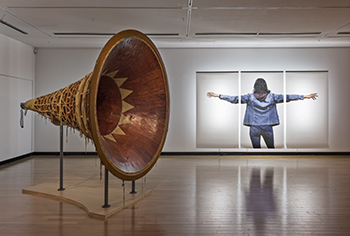 Installation view. Courtesy of Justina M. Barnicke Gallery.
Installation view. Courtesy of Justina M. Barnicke Gallery.
Creating artwork that addresses taboo, political, religious or cultural issues has many challenges, one of which is relaying the intended message in an impactful way that does not fall into the trap of being cliché. Only some pieces in KWE successfully combined ethics and aesthetics while others lacked this quality. This disjunction creates an exhibit that is more confusing than poetic.
Mia Guttmann
*Exhibition information: May 15 – August 9, 2014, Justina M. Barnicke Gallery, 7 Hart House Circle, Toronto. Gallery hours: Mon – Fri, 12 – 5; Sat, 1 –5 p.m.

